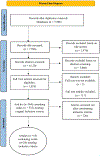A Systematic Review of Validated Measures of U.S.-Based Bystander Intervention-Related Constructs
- PMID: 36514242
- PMCID: PMC10261542
- DOI: 10.1177/15248380221137067
A Systematic Review of Validated Measures of U.S.-Based Bystander Intervention-Related Constructs
Abstract
This review aimed to identify U.S.-based, construct-validated measures of bystander intervention. Following PRISMA-P guidelines, electronic databases were searched, and emails were solicited identifying 8,559 articles for title screening. Abstracts and full texts were double screened, resulting in 24 scales meeting inclusion criteria: (a) measured a bystander-related construct in a situation where there was a potential for actual or perceived imminent physical or emotional harm, (b) written in English, and (c) statistically validated on U.S. samples. Most scales addressed the domain of interpersonal violence (67%), with fewer relating to bias/bullying (8.2%), mental health crises (12.5%), and substance use (12.5%). Most scales (71%) assessed the "take action" step of the situational model. The modal construct represented was intent/willingness/likelihood to intervene (50%). The average number of items on a scale was 14, and most (79%) provided Likert-style response options. None of the validated scales assessing behavior first accounted for an opportunity. Sample sizes ranged from 163 to 3,397, with the modal setting from colleges. Overall, samples were young (21.8 years old), White (75%), women (64%), and heterosexual (89%). Results indicate the need to validate additional measures that capture the "interpreting the situation as problematic" step of the situational model. Scales also need to be validated using diverse samples, particularly within the mental health crisis domain. Across all domains, validated measures need to be developed that first account for an opportunity when measuring actual bystander behavior. The information gleaned can be used to assist researchers in selecting measures and guide future measure development.
Keywords: bystander behavior; bystander intervention; bystander self-efficacy; intentions to intervene.
Conflict of interest statement
Declaration of Conflicting InterestsThe author(s) declared no potential conflicts of interest with respect to the research, authorship, and/or publication of this article.
References
-
- Ajzen I (1985). From intentions to action: A theory of planned behavior. In Kuhl J & Beckmann J (Eds.), Action control. SSSP Springer Series in Social Psychology. Springer. 10.1007/978-3-642-69746-3_2 - DOI
-
- Angoff HD, & Barnhart WR (2021). Bullying and cyberbullying among LGBQ and heterosexual youth from an intersectional perspective: Findings from the 2017 National Youth Risk Behavior Survey. Journal of School Violence, 20(3), 274–286. 10.1080/15388220.2021.1879099 - DOI
Publication types
MeSH terms
Grants and funding
LinkOut - more resources
Full Text Sources


